7 – 14 OCTOBER 2023
By Dominic Rollinson
Overview
This short but relatively intense Cape birding tour was designed to take in some of the best birding in the general Cape area, including a couple days in the semi-desert of the Tankwa Karoo, while also enjoying some beautiful scenery. The tour started with a few days in Cape Town where we undertook day tours, before making our way up the west coast to Langebaan and inland through the Cederberg Mountains into the Tankwa Karoo, where we targeted many South African endemics and near-endemics. We then ended back in Cape Town where we targeted a few missing species. The trip was meant to include a Cape Town pelagic, however, despite having three full days set aside for our sea trip, we could not get a weather gap and instead had to settle for a trip down to Cape Point where we enjoyed some land-based seabirding and took in the area’s impressive scenery.
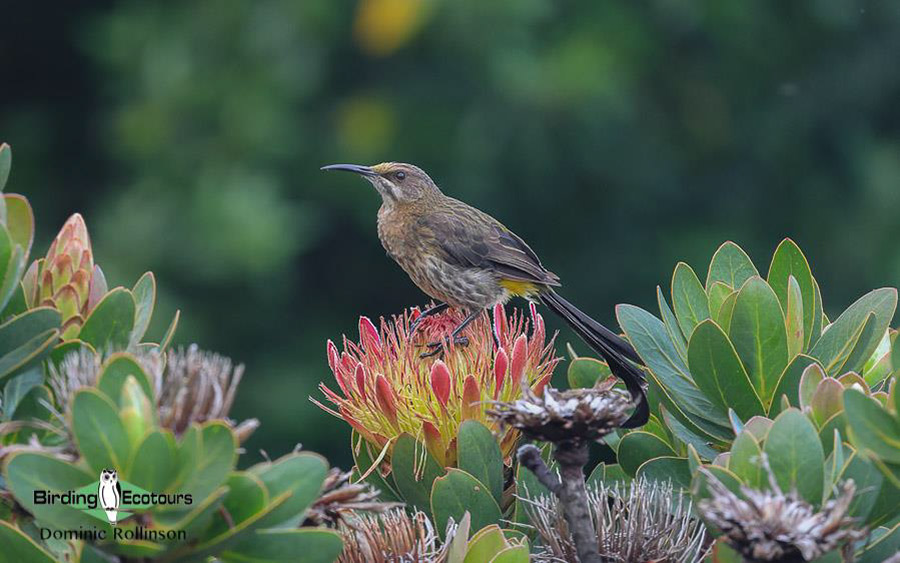
Cape Sugarbird gave us the classic ‘sugarbird pose’ in Kirstenbosch Botanical Garden.
Over our eight days of Cape birding we racked up an impressive 228 bird species which included many of the Cape’s endemics and specials. Some of our highlights included Grey-winged Francolin, Karoo and Southern Black Korhaans, Namaqua Sandgrouse, African Penguin, Bank, Cape and Crowned Cormorants, Black Harrier, Ground Woodpecker, Cape Rockjumper, Fairy Flycatcher, Grey Tit, Cape Penduline Tit, nine lark species (including many Black-eared Sparrow-Larks), Victorin’s Warbler (annoyingly only seen by one of the group, despite our best efforts), Rufous-eared, Cinnamon-breasted and Layard’s Warblers, Dusky Sunbird and Protea, Forest and Black-headed Canaries.
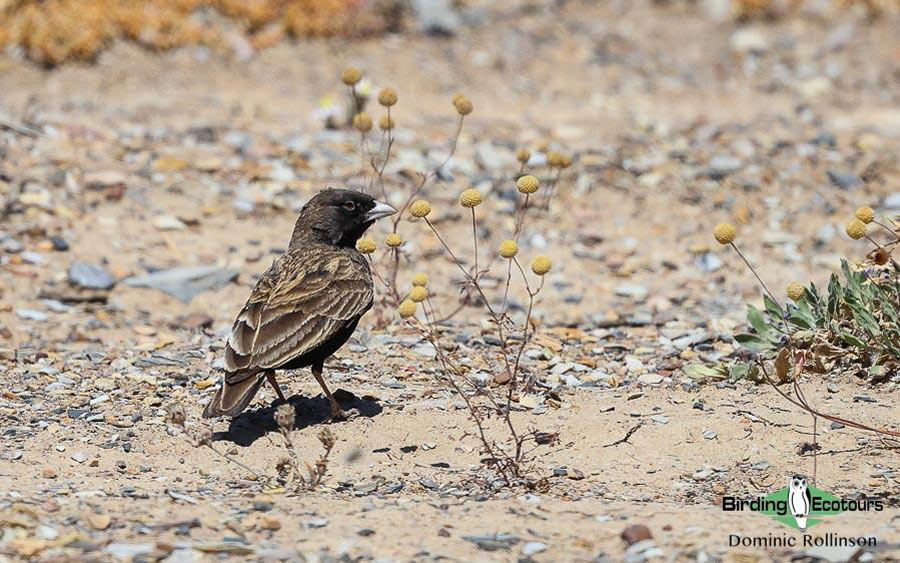
The erratic Black-eared Sparrow-Lark was numerous in the Tankwa Karoo.
Detailed Report
Day 1, 07th October 2023. Arrival in Cape Town and Kirstenbosch birding
With all members of the group having arrived by the early afternoon, we headed out for our first birding of the tour with a walk around the famous Kirstenbosch Botanical Garden. The wind was quite strong this afternoon (something we would have to contend with for large periods of this trip) however we still managed to find a good selection of forest- and garden-associated species. Soon after entering the gate we had a dark-phase Booted Eagle high up above our heads which would then continue to show on and off for the remainder of the afternoon. We slowly worked our way through the picturesque gardens (with a stunning view of Table Mountain as a backdrop) and managed to find Cape Spurfowl, Karoo Prinia, Black Saw-wing, Cape Bulbul, Cape White-eye, Olive Thrush, Cape Sugarbird (lovely looks at a pair), Amethyst, Malachite and Southern Double-collared Sunbirds, Forest Canary, Common Chaffinch (an introduced, yet range-restricted species in South Africa) and Swee Waxbill. The shaded undergrowth of a forested section of the gardens produced the goods with a couple of Lemon Doves which showed well for us. We then headed out for an enjoyable dinner where we excitedly discussed the trip ahead.
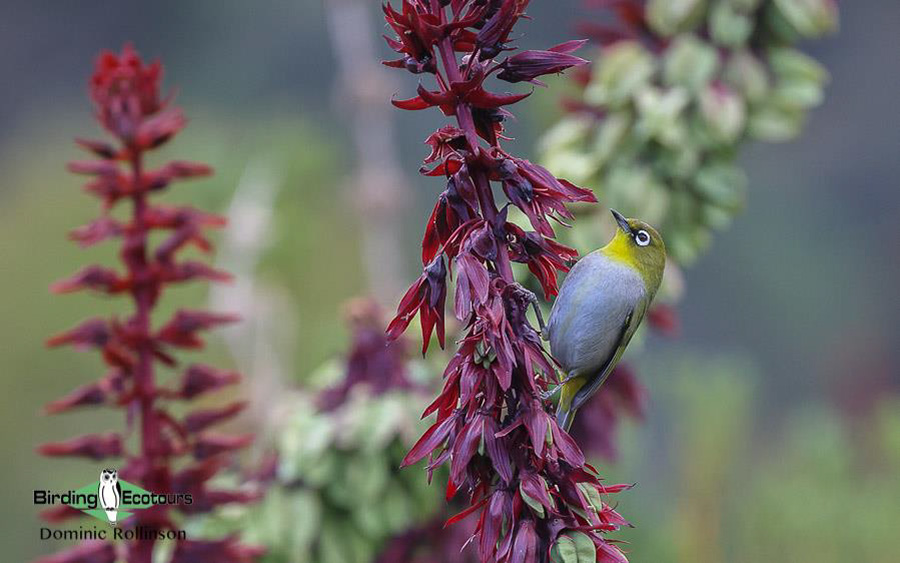
Although common, Cape White-eyes are always a pleasant sight to see.
Day 2, 08th October 2023. West coast birding
With the outlook not looking great for our pelagic trip, we headed up the west coast today, to give us another full day in our weather window to try head out to sea. It was another windy day but the birding got off to a good start with a stop at Sunset Beach Pan which held a few White-backed Ducks as well as our first looks at Cape Shoveler, Yellow-billed Duck, Great Crested Grebe, Black-crowned Night Heron and Southern Red Bishop. Another stop, just around the corner, yielded much the same birds with the addition of African Palm Swift (a localized bird in the Cape) in amongst the many Little and White-rumped Swifts.
A little further north we birded the Silwerstroomstrand area which proved incredibly productive and we soon found our target bird, Black Harrier, which hung around for a while as it hunted low over the strandveld vegetation. Other nice birds seen here included Black-winged Kite, African Marsh Harrier, White-backed Mousebird, European Bee-eater, Bokmakierie, Cape Penduline Tit, Cape Clapper Lark (performing their aerial displays), Cape Grassbird, Grey-backed Cisticola, Pearl-breasted Swallow, Karoo Scrub Robin, Pied Starling, Cape Weaver, Brimstone (surprisingly, as they are unusual on the west coast) and Yellow Canaries and Cape Bunting. We tried for Grey Tit and Karoo Thrush which had been seen recently in the area but they were seemingly not around this morning.
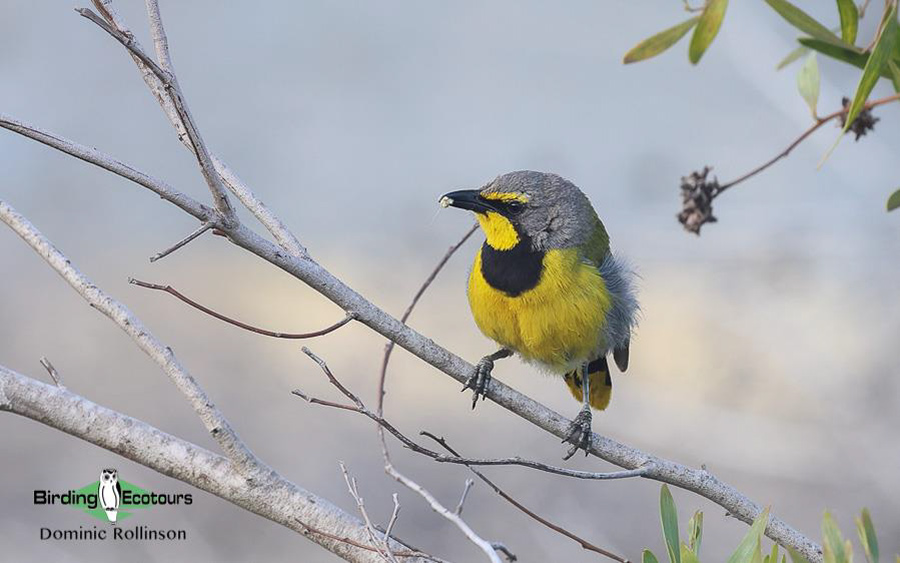
The bright Bokmakierie was commonly encountered on this Cape birding tour.
Next, was a brief stop at Tienie Versveld Wildflower Reserve where we immediately heard Cloud Cisticola displaying, however, seeing the birds was a different story. After a while some of us managed to spot a tiny dot high up in the sky as the males performed their aerial display. Other birds seen in the area included South African Shelduck, Great White Pelican (a distant group of three), Lanner Falcon, Cape Longclaw, Red-capped Lark, African Stonechat, Capped Wheatear (always a crowd favorite), African Pipit and Yellow Bishop.
We had now taken a few hours to make our way up the west coast and we finally entered West Coast National Park, where we spent most of the remainder of the afternoon. A stop at Abrahamskraal bird hide was particularly busy with birds constantly coming down to the water to drink. Waterbirds included Little Grebe, Cape Shoveler, African Spoonbill, African Rail (heard only) and a couple of Lesser Swamp Warblers flitting about in the reedbeds. Other birds seen nearby included Rock Kestrel, Namaqua Dove, Banded Martin and Cape Bulbul.
We then enjoyed a light sit-down lunch at Geelbek Manor House and while waiting for our food, we took a walk around and found African Hoopoe, Cardinal Woodpecker and a single Grey-winged Francolin. As we left the manor house, we were very surprised to see a Secretarybird fly over and land in a distant field, an unusual bird in the park. In the area, we also encountered an impressive Common Eland herd, one of the largest antelope in the world.
To finish off the afternoon in the park, we visited Seeberg bird hide which had good numbers of water-associated species around. Just before arriving at the hide, Catherine spotted a single male Southern Black Korhaan which was a welcome sight. Greater and Lesser Flamingoes were numerous and we enjoyed good looks at these popular birds, while we also found African Oystercatcher, Black-winged Stilt, Grey, Kittlitz’s and White-fronted Plovers, Eurasian Whimbrel, Sanderling, Curlew Sandpiper and a suite of tern species including Caspian, Common, Greater Crested and Sandwich Terns. We then took the long drive back to Cape Town, enjoying a Puff Adder crossing the road in the reserve, ending a highly successful day of west coast birding.
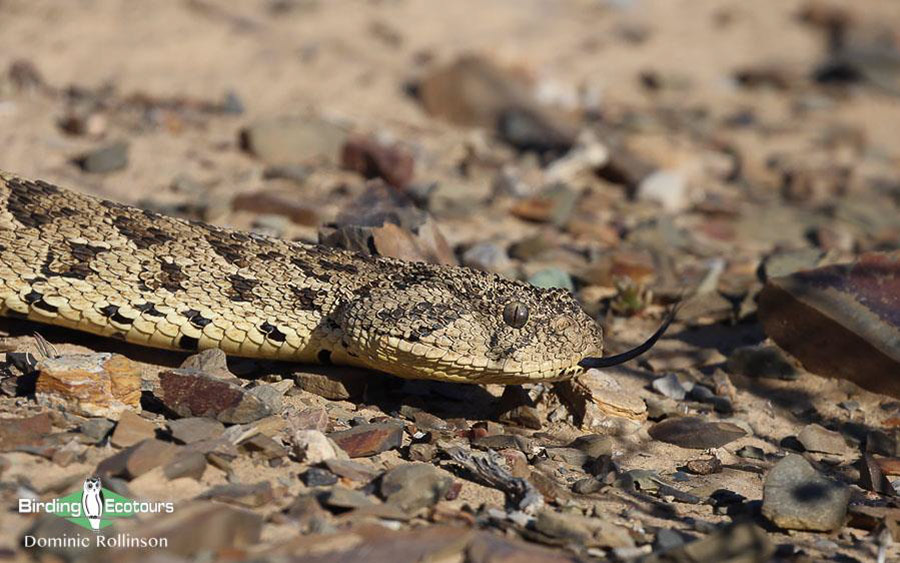
We had two fantastic Puff Adder encounters on this tour.
Day 3, 09th October 2023. Rockjumpers and birding Betty’s Bay
With the wind blowing even worse than yesterday, we had another early start and started making our way east. We stopped at Sir Lowry’s Pass and almost immediately flushed an eagle-owl, unfortunately our views were just too brief to determine whether it was the common Spotted or rare Cape Eagle-Owl. We heard several Victorin’s Warblers however despite a concentrated effort, we could not see any of these singing birds. Bill did manage a look at a bird while we were all facing the other way, but the wind just proved too ferocious to try get looks at these notorious skulkers. While looking for the warblers, we spotted Common and Jackal Buzzards and White-necked Ravens flying overhead.
Due to the intense storm that had ravaged the Cape the previous week, the picturesque Clarence Drive was closed which meant we had to take the long way round to Rooi-Els, however we soon arrived at our spot to look for rockjumpers. The wind was again blowing a gale and it took some time but we eventually managed to find a relatively close pair of Cape Rockjumpers which we all enjoyed scope views of. Other birds encountered here included Orange-breasted Sunbird, Familiar Chat, Cape Bunting and a calling Streaky-headed Seedeater which soon disappeared as we approached its bush.
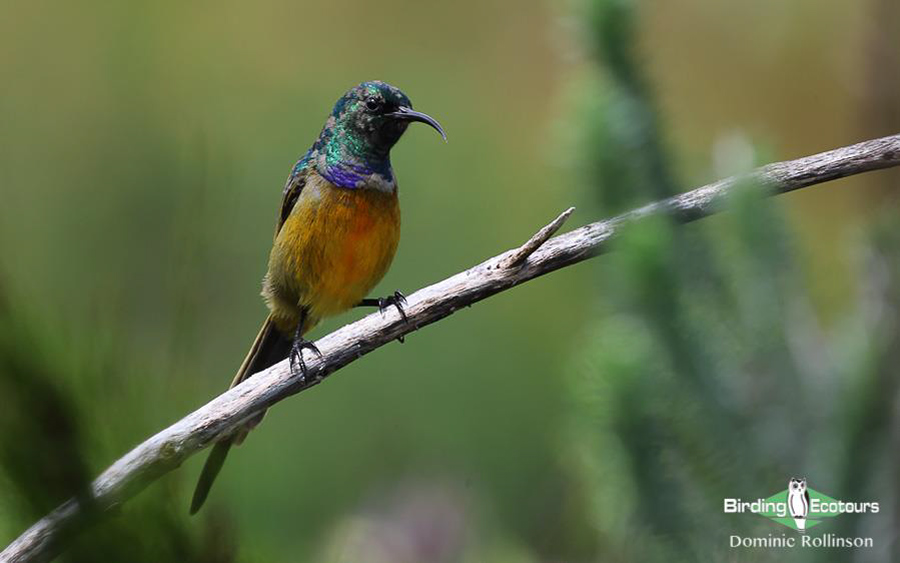
The colorful Orange-breasted Sunbird is an abundant resident of mountain fynbos.
We had a relaxed picnic lunch at Harold Porter Botanical Garden (without any interference from marauding Chacma Baboons) and afterwards took a (windy) walk around the gardens which did not prove terribly productive. We did however find Cape Spurfowl, Bar-throated Apalis, Karoo Prinia, Grey-backed Cisticola, Sombre Greenbul (well spotted, Ohad), African Dusky Flycatcher and Cape Sugarbird.
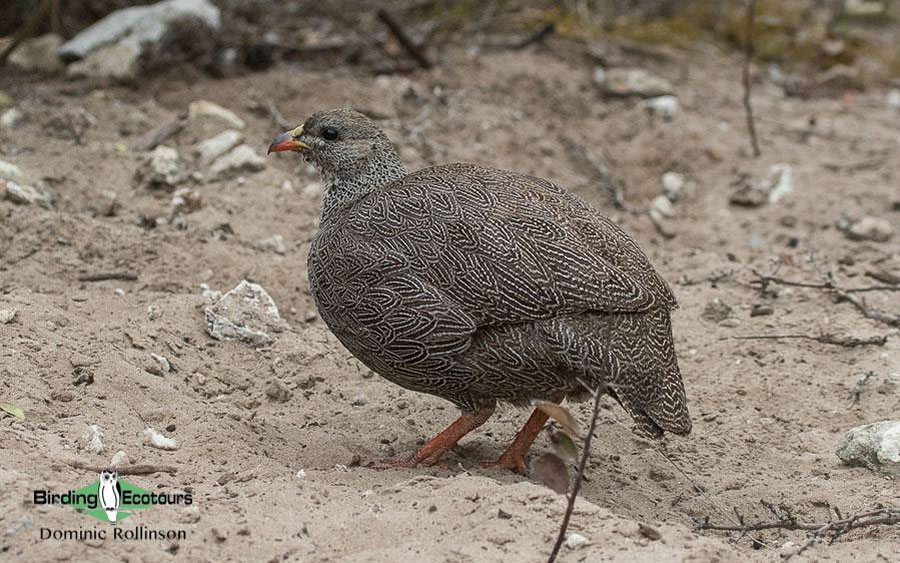
The endemic Cape Spurfowl is normally straightforward to find in the Cape.
A brief stop at the Stony Point penguin colony in Betty’s Bay saw us enjoying the cute and comical African Penguins and we managed to pick out Bank, Crowned and Cape Cormorants breeding on the nearby rocks.
We decided to bird a rocky ridge near Betty’s Bay in the hopes of finding a few missing specials which proved to a be a good decision, as this spot was slightly sheltered from the wind. Cape Rockjumper showed better than before at Rooi-Els and we also found Ground Woodpecker, Cape Rock Thrush, Cape Siskin (unfortunately missed by some of the group) and calling Neddicky which was determined not to reveal itself to us. After a long, windy day out we headed back to Cape Town, it had been a tough day of birding but our perseverance meant we had seen just about all the day’s major targets.
Day 4, 10th October 2023. Cape Point birding and transfer to the west coast
We had been given the bad news the previous evening that our pelagic trip had been cancelled as we could not get a break in the weather, so decided to head down to Cape Point for the morning. The day started with a displaying African Goshawk as it gave its piercing ‘chip’ call high above our heads. We then made our way south along the peninsula (spotting a hunting Black Sparrowhawk en route) and arrived at the Cape of Good Hope National Park (to be greeted by strong winds). We had our picnic breakfast at the actual Cape of Good Hope (the most southwesterly point of Africa) which, despite the strong winds, proved quite enjoyable. There were a number of seabirds out at sea (although I was expecting greater numbers) and some scanning revealed White-chinned Petrel, Sooty Shearwater, Cape Gannet and a single Northern Giant Petrel. The rocks nearby had Common, Greater Crested and Sandwich Terns, African Oystercatcher and a large group of Afro-Australian Fur Seals.
We then moved around the corner to Cape Point and took a gentle stroll below the car park (Ed took a run up to the top lighthouse) where we saw Speckled Mousebird, a flyby Ground Woodpecker and had brief views of Cape Siskin. It was then time to head north and soon after leaving the reserve we found a pair of confiding Olive Woodpeckers which we had missed previously.
After the long drive north, checking into our Langebaan accommodation and some time off, we headed back out for some late afternoon birding which proved highly productive. We birded some farmlands en route to Jacob’s Bay and here we found Black Harrier, Crowned Lapwing, Large-billed and Red-capped Larks, Banded Martin, Pearl-breasted Swallow and a distant pair of Blue Cranes.
We then birded around the small coastal town of Jacob’s Bay where an inspection of the tern roost revealed a single Antarctic Tern in amongst the Greater Crested, Common and Sandwich Terns, with Ruddy Turnstone and White-fronted Plover seen feeding on the rocks. The surrounding strandveld had some great birds including Spotted Thick-knee, Karoo Lark, Cape Long-billed Lark, White-backed Mousebird and Bokmakierie. We then ended the day with a nighttime venture which resulted in good looks at our target bird, Fiery-necked Nightjar.
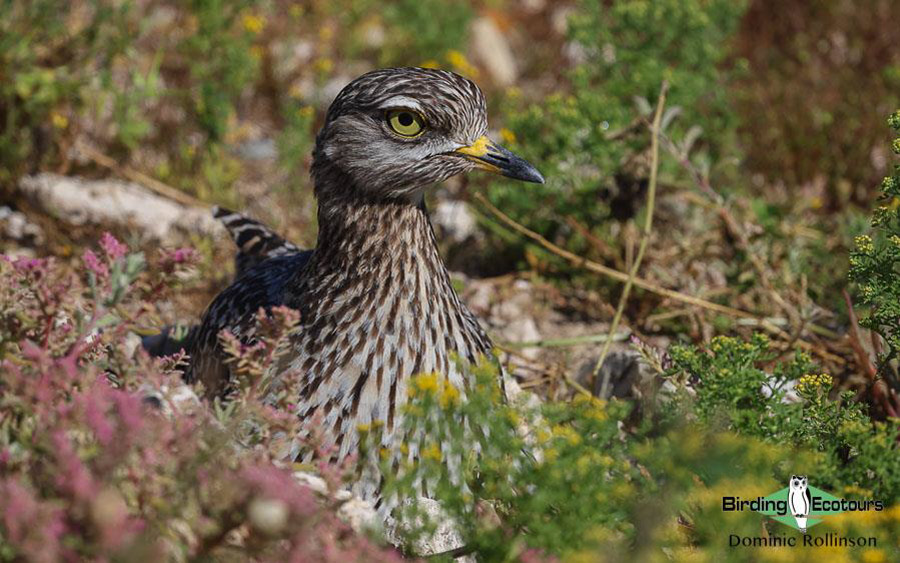
Spotted Thick-knees were common and confiding in Jacob’s Bay.
Day 5: 11th October 2023. Birding the west coast and transfer to the Tankwa Karoo
We started the morning with a delicious sit-down breakfast before we headed to the local quarry where it did not take long for our target bird to appear, a majestic pair of Verreaux’s Eagles. We had a quick spin around Jacob’s Bay again in the hope of improving our views of Grey-winged Francolin but had to settle for a showy Grey Tit.
We then continued our way up the west coast and stopped in at the salt works near Velddrif which was, as usual, full of birds. In very little time, we racked up a good bird list, many of which were new birds for the tour including Cape Teal, Black-necked Grebe, Pied Avocet, Chestnut-banded Plover, Ruff, Common Sandpiper, Red-necked Phalarope, Common Greenshank, African Darter, Reed Cormorant, Black-crowned Night Heron, Glossy Ibis, African Spoonbill, African Marsh Harrier, Pied Kingfisher and European Bee-eater.
After a quick pit stop in town, we hit the long road to the Tankwa Karoo and crossed through the southern end of the Cederberg Mountains (our lunch stop producing a Long-billed Crombec), enjoying the impressive views along the way. The drive was mostly quiet until we crossed the Katbakkies Pass where things started to heat up (both the birding and the temperature). Within a fairly short period of time we had found Layard’s Warbler, Protea Canary, Pale Chanting Goshawk and a small group of Black-headed Canaries before we descended into the plains of the Tankwa Karoo and took it easy for the remainder of the afternoon. We decided to do a night drive that evening which was not terribly productive, although we did get nice views of Spotted Eagle-Owl, Klipspringer and Scrub Hare and enjoyed the spectacular astronomical display out here in the wilderness, far away from any light pollution.
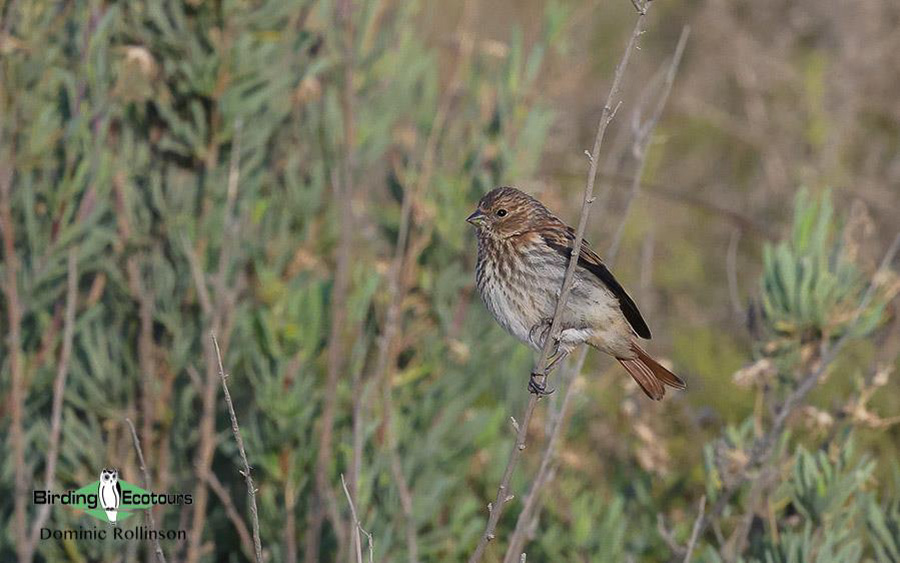
Black-headed Canaries, such as this juvenile, were abundant around the Tankwa Karoo.
Day 6, 12th October 2023. Tankwa Karoo birding
We had the full day to explore the dry gorges and plains of the Tankwa Karoo today and had a long list of target birds to aim for. We started the day by birding around our guest farm and the nearby Skitterykloof which added many of our dry country targets. Not far from the accommodation, we found Karoo Lark, Karoo Eremomela, Rufous-eared Warbler, Karoo Chat, Nicholson’s Pipit, White-throated Canary and Lark-like Bunting. An hour or so at Skitterykloof yielded Cinnamon-breasted Warbler (which didn’t really put up a fight today) as well as Pale Chanting Goshawk, Fairy Flycatcher, Grey Tit, Common Reed Warbler, Layard’s Warbler, a pair of flyover Pale-winged Starlings and more Black-headed Canaries.
We then had a lovely sit-down breakfast before heading out into the Tankwa Karoo (armed with lunch packs) for the remainder of the day. With all the rain the area had received over the last few months, the plains were alive with birds and we enjoyed some of the best birding I have ever experienced in the Tankwa Karoo. Our first stop at a dry acacia-lined river bed soon added Pririt Batis, Chestnut-vented Warbler and Namaqua Warbler with repeat views of Fairy Flycatcher and White-throated Canary. Moving further north into the plains we soon started to notice flocks of sparrow-larks flying by and on closer inspection it revealed they were predominantly the highly nomadic and unpredictable Black-eared Sparrow-Lark, as well as smaller numbers of Grey-backed Sparrow-Larks. The Black-eared Sparrow-Larks took some time to get decent views of but eventually we all had excellent views as they went about feeding on the ground.
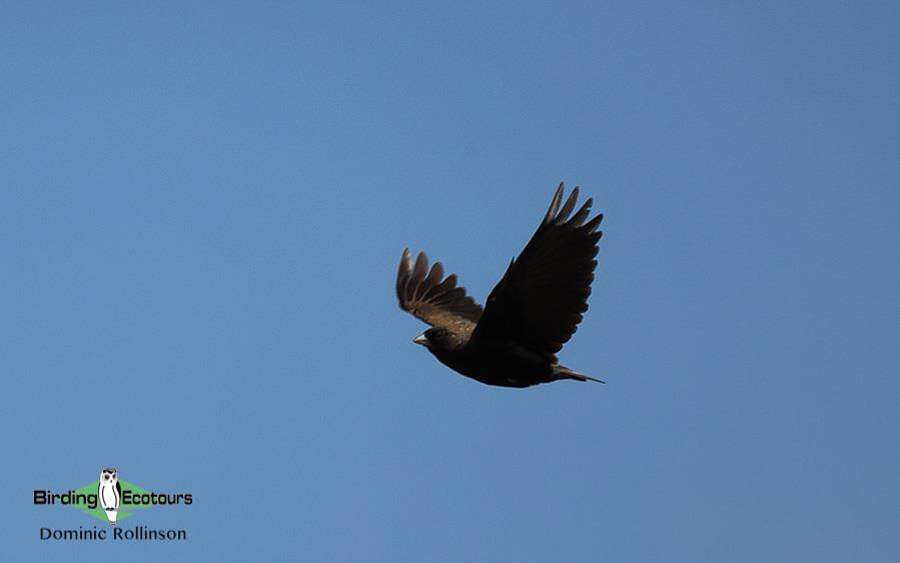
It’s always special to see nomadic Black-eared Sparrow-Larks in the Tankwa Karoo.
We kept heading north and ultimately made it all the way into the Tankwa Karoo National Park, along the way we kept adding new birds such as Namaqua Sandgrouse, Greater Kestrel, Spike-heeled Lark, Tractrac Chat, Dusky Sunbird and a Karoo Long-billed Lark, at our turnaround point. On our way back out of the park, we had a distant sighting of a Secretarybird and a subadult Black-chested Snake Eagle which was the surprise of the day. We had some nice mammal sightings this afternoon too, with Steenbok, Springbok and Gemsbok (Southern Oryx) all being seen well. To finish the day’s birding, we had another lovely sighting of a Puff Adder as it crossed the road. We made it back to our accommodation late in the afternoon and again decided to take the remainder of the day off, after a highly successful day out, with just about all our targets seen.
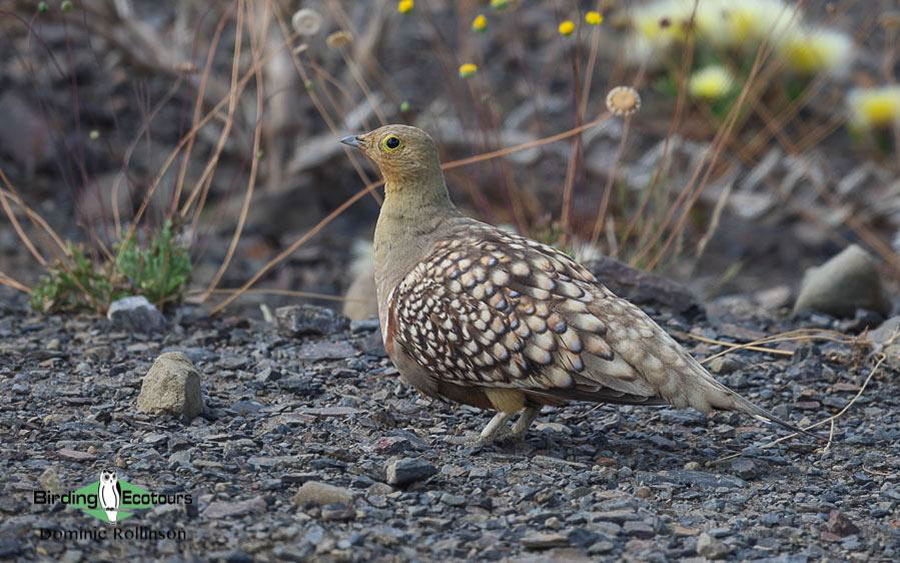
We had a few good Namaqua Sandgrouse sightings in the Tankwa Karoo.
Day 7, 13th October 2023. Tankwa karoo birding and transfer to Cape Town
We had an early sit-down breakfast today before loading up the van and slowly making our way out of the plains of the Tankwa Karoo. We still had a couple targets left over from yesterday and so stopped at a dry river bed where Yellow-bellied Eremomela soon obliged. Next up was Karoo Korhaan which did not take too much work however the scope views were a little distant. Our final stop for some dry country birding was at the Karooport farmhouse where we unsuccessfully tried to turn an Olive Thrush into a Karoo Thrush but did find Acacia Pied Barbet and more Black-headed Canaries.
We drove the scenic Bain’s Kloof Pass on the way back to Cape Town in the hopes of finding Victorin’s Warbler but unfortunately, we could not even hear any birds singing today, despite the glorious weather. We did however finally catch up with an obliging Neddicky, had brief views of Cape Siskin and managed lovely looks at a singing Cape Rock Thrush.
We made it back into our Cape Town accommodation in the early afternoon and took some time off before heading out to Strandfontein Sewage Works for the remainder of the afternoon. Ed decided this was at last his weather window to head up Table Mountain and left the group to enjoy an afternoon on Cape Town’s iconic peaks. As usual, the sewage works were full of birds and we managed to track down most of our missing targets. In amongst the masses of common waterbirds and wildfowl, we found Fulvous Whistling Duck, Southern Pochard, Maccoa Duck, African Swamphen, Grey-headed Gull, Whiskered Tern and Bar-tailed Godwit. We also had better looks at Lesser Swamp Warbler and managed brief views of Little Rush Warbler.
After dinner we had a quick nocturnal birding session to try find a resident pair of African Wood Owls which were a no-show however, we did hear the foghorn-like call of Buff-spotted Flufftail which was quite something to experience.
Day 8, 14th October 2023. Cape Town birding and departure
Most of the group’s flights were around mid-morning today and so we had an hour or so before breakfast to see if we could track down any new birds before we made our way to the airport. We birded a nearby river which soon yielded African Black Duck and Malachite Kingfisher and we vastly improved our views of Little Rush Warbler. We then moved to a nearby patch of exotic trees where we had lovely views of a pair of Rufous-breasted Sparrowhawks and added an African Harrier-Hawk nearby.
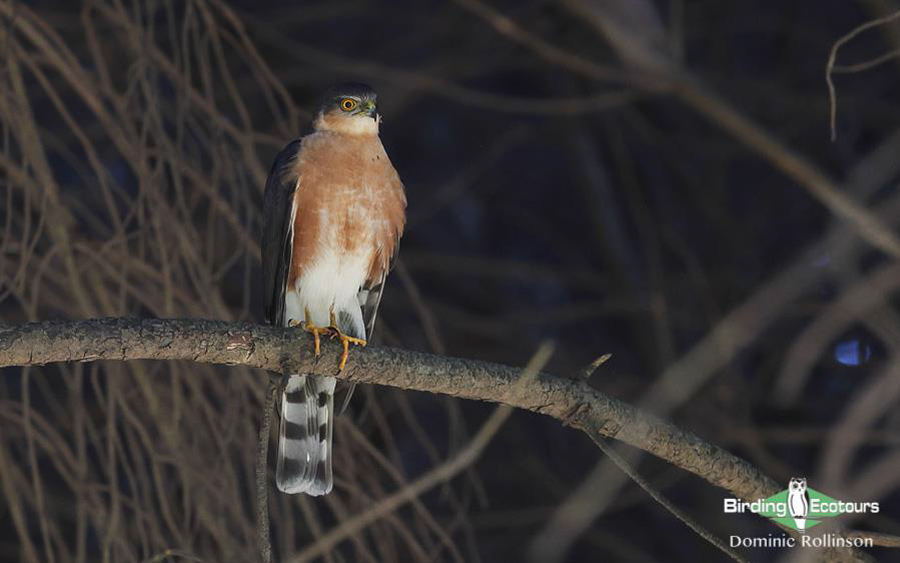
We could not have asked for better views of Rufous-breasted Sparrowhawk near Cape Town.
We enjoyed a sit-down breakfast back at our accommodation before I dropped off most of the group at the airport for their flights. John only flew out later in the day and so we had a couple hours to bird in the leafy suburbs of Cape Town. Here, we enjoyed a good walk through one of the greenbelts (before John’s long international flight) and added African Paradise Flycatcher, Bronze Mannikin (an introduced population here in the Cape) and a showy pair of Cape Batises.
This ended a highly successful and thoroughly enjoyable week’s birding in the Cape. Despite the strong wind for large parts of the tour, we managed to find almost all our targets, with the Tankwa Karoo being a tour highlight for most of the group. Thanks everybody for making it such a fun trip.
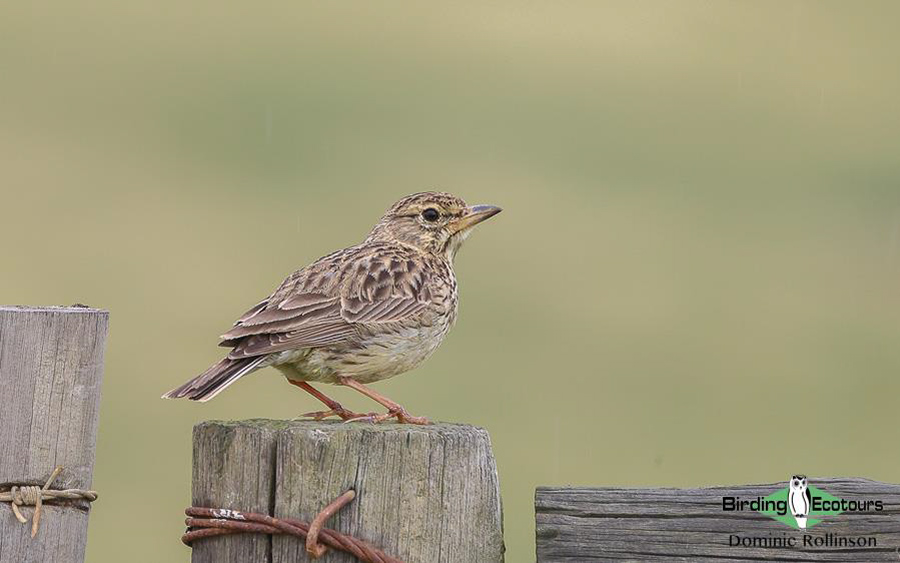
Large-billed Lark was one of the nine lark species we saw on this Cape birding tour.
Bird List – Following IOC (13.2)
Birds ‘heard only’ are marked with (H) after the common name, birds seen by the guide only are marked with a (G) after the common name, all other species were seen both by clients and guide.
The following notation after species names is used to show conservation status following BirdLife International. EN = Endangered, VU = Vulnerable, NT = Near-Threatened.
| Common Name | Scientific Name |
| Ostriches (Struthionidae) | |
| Common Ostrich | Struthio camelus |
| Ducks, Geese, Swans (Anatidae) | |
| Fulvous Whistling Duck | Dendrocygna bicolor |
| White-backed Duck | Thalassornis leuconotus |
| Spur-winged Goose | Plectropterus gambensis |
| Egyptian Goose | Alopochen aegyptiaca |
| South African Shelduck | Tadorna cana |
| Cape Shoveler | Spatula smithii |
| African Black Duck | Anas sparsa |
| Yellow-billed Duck | Anas undulata |
| Cape Teal | Anas capensis |
| Red-billed Teal | Anas erythrorhyncha |
| Southern Pochard | Netta erythrophthalma |
| Maccoa Duck – EN | Oxyura maccoa |
| Guineafowl (Numididae) | |
| Helmeted Guineafowl | Numida meleagris |
| Pheasants & Allies (Phasianidae) | |
| Grey-winged Francolin | Scleroptila afra |
| Cape Spurfowl | Pternistis capensis |
| Nightjars (Caprimulgidae) | |
| Fiery-necked Nightjar | Caprimulgus pectoralis |
| Swifts (Apodidae) | |
| African Palm Swift | Cypsiurus parvus |
| Alpine Swift | Tachymarptis melba |
| African Black Swift | Apus barbatus |
| Little Swift | Apus affinis |
| White-rumped Swift | Apus caffer |
| Bustards (Otididae) | |
| Karoo Korhaan | Heterotetrax vigorsii |
| Southern Black Korhaan – VU | Afrotis afra |
| Sandgrouse (Pteroclidae) | |
| Namaqua Sandgrouse | Pterocles namaqua |
| Pigeons, Doves (Columbidae) | |
| Rock Dove | Columba livia |
| Speckled Pigeon | Columba guinea |
| Lemon Dove | Columba larvata |
| Red-eyed Dove | Streptopelia semitorquata |
| Ring-necked Dove | Streptopelia capicola |
| Laughing Dove | Spilopelia senegalensis |
| Namaqua Dove | Oena capensis |
| Rails, Crakes & Coots (Rallidae) | |
| African Rail | Rallus caerulescens |
| Common Moorhen | Gallinula chloropus |
| Red-knobbed Coot | Fulica cristata |
| African Swamphen | Porphyrio madagascariensis |
| Cranes (Gruidae) | |
| Blue Crane – VU | Grus paradisea |
| Grebes (Podicipedidae) | |
| Little Grebe | Tachybaptus ruficollis |
| Great Crested Grebe | Podiceps cristatus |
| Black-necked Grebe | Podiceps nigricollis |
| Flamingos (Phoenicopteridae) | |
| Greater Flamingo | Phoenicopterus roseus |
| Lesser Flamingo | Phoeniconaias minor |
| Stone-curlews, Thick-knees (Burhinidae) | |
| Spotted Thick-knee | Burhinus capensis |
| Oystercatchers (Haematopodidae) | |
| African Oystercatcher | Haematopus moquini |
| Stilts, Avocets (Recurvirostridae) | |
| Black-winged Stilt | Himantopus himantopus |
| Pied Avocet | Recurvirostra avosetta |
| Plovers (Charadriidae) | |
| Blacksmith Lapwing | Vanellus armatus |
| Crowned Lapwing | Vanellus coronatus |
| Grey Plover | Pluvialis squatarola |
| Common Ringed Plover | Charadrius hiaticula |
| Kittlitz’s Plover | Charadrius pecuarius |
| Three-banded Plover | Charadrius tricollaris |
| White-fronted Plover | Charadrius marginatus |
| Chestnut-banded Plover | Charadrius pallidus |
| Sandpipers, Snipes (Scolopacidae) | |
| Eurasian Whimbrel | Numenius phaeopus |
| Bar-tailed Godwit | Limosa lapponica |
| Ruddy Turnstone | Arenaria interpres |
| Ruff | Calidris pugnax |
| Curlew Sandpiper | Calidris ferruginea |
| Sanderling | Calidris alba |
| Little Stint | Calidris minuta |
| Red-necked Phalarope | Phalaropus lobatus |
| Common Sandpiper | Actitis hypoleucos |
| Common Greenshank | Tringa nebularia |
| Gulls, Terns, Skimmers (Laridae) | |
| Grey-headed Gull | Chroicocephalus cirrocephalus |
| Hartlaub’s Gull | Chroicocephalus hartlaubii |
| Kelp Gull | Larus dominicanus |
| Caspian Tern | Hydroprogne caspia |
| Greater Crested Tern | Thalasseus bergii |
| Sandwich Tern | Thalasseus sandvicensis |
| Common Tern | Sterna hirundo |
| Antarctic Tern | Sterna vittata |
| Whiskered Tern | Chlidonias hybrida |
| Penguins (Spheniscidae) | |
| African Penguin – EN | Spheniscus demersus |
| Petrels, Shearwaters, Diving Petrels (Procellariidae) | |
| Northern Giant Petrel | Macronectes halli |
| White-chinned Petrel – VU | Procellaria aequinoctialis |
| Sooty Shearwater | Ardenna grisea |
| Gannets, Boobies (Sulidae) | |
| Cape Gannet – EN | Morus capensis |
| Anhingas, Darters (Anhingidae) | |
| African Darter | Anhinga rufa |
| Cormorants, Shags (Phalacrocoracidae) | |
| Reed Cormorant | Microcarbo africanus |
| Crowned Cormorant | Microcarbo coronatus |
| Bank Cormorant – EN | Phalacrocorax neglectus |
| Cape Cormorant – EN | Phalacrocorax capensis |
| White-breasted Cormorant | Phalacrocorax lucidus |
| Ibises, Spoonbills (Threskiornithidae) | |
| African Sacred Ibis | Threskiornis aethiopicus |
| Hadada Ibis | Bostrychia hagedash |
| Glossy Ibis | Plegadis falcinellus |
| African Spoonbill | Platalea alba |
| Herons, Bitterns (Ardeidae) | |
| Black-crowned Night Heron | Nycticorax nycticorax |
| Western Cattle Egret | Bubulcus ibis |
| Grey Heron | Ardea cinerea |
| Black-headed Heron | Ardea melanocephala |
| Little Egret | Egretta garzetta |
| Pelicans (Pelecanidae) | |
| Great White Pelican | Pelecanus onocrotalus |
| Secretarybird (Sagittariidae) | |
| Secretarybird – EN | Sagittarius serpentarius |
| Kites, Hawks, Eagles (Accipitridae) | |
| Black-winged Kite | Elanus caeruleus |
| African Harrier-Hawk | Polyboroides typus |
| Black-chested Snake Eagle | Circaetus pectoralis |
| Booted Eagle | Hieraaetus pennatus |
| Verreaux’s Eagle | Aquila verreauxii |
| Pale Chanting Goshawk | Melierax canorus |
| African Goshawk | Accipiter tachiro |
| Rufous-breasted Sparrowhawk | Accipiter rufiventris |
| Black Sparrowhawk | Accipiter melanoleucus |
| African Marsh Harrier | Circus ranivorus |
| Black Harrier – EN | Circus maurus |
| Yellow-billed Kite | Milvus aegyptius |
| Common Buzzard | Buteo buteo |
| Jackal Buzzard | Buteo rufofuscus |
| Owls (Strigidae) | |
| Spotted Eagle-Owl | Bubo africanus |
| Mousebirds (Coliidae) | |
| Speckled Mousebird | Colius striatus |
| White-backed Mousebird | Colius colius |
| Red-faced Mousebird | Urocolius indicus |
| Hoopoes (Upupidae) | |
| African Hoopoe | Upupa africana |
| Kingfishers (Alcedinidae) | |
| Malachite Kingfisher | Corythornis cristatus |
| Pied Kingfisher | Ceryle rudis |
| Bee-eaters (Meropidae) | |
| European Bee-eater | Merops apiaster |
| African Barbets (Lybiidae) | |
| Acacia Pied Barbet | Tricholaema leucomelas |
| Woodpeckers (Picidae) | |
| Ground Woodpecker | Geocolaptes olivaceus |
| Cardinal Woodpecker | Dendropicos fuscescens |
| Olive Woodpecker | Dendropicos griseocephalus |
| Caracaras, Falcons (Falconidae) | |
| Rock Kestrel | Falco rupicolus |
| Greater Kestrel | Falco rupicoloides |
| Lanner Falcon | Falco biarmicus |
| Wattle-eyes, Batises (Platysteiridae) | |
| Cape Batis | Batis capensis |
| Pririt Batis | Batis pririt |
| Bushshrikes (Malaconotidae) | |
| Bokmakierie | Telophorus zeylonus |
| Southern Boubou | Laniarius ferrugineus |
| Drongos (Dicruridae) | |
| Fork-tailed Drongo | Dicrurus adsimilis |
| Monarchs (Monarchidae) | |
| African Paradise Flycatcher | Terpsiphone viridis |
| Shrikes (Laniidae) | |
| Southern Fiscal | Lanius collaris |
| Crows, Jays (Corvidae) | |
| House Crow | Corvus splendens |
| Pied Crow | Corvus albus |
| White-necked Raven | Corvus albicollis |
| Rockjumpers (Chaetopidae) | |
| Cape Rockjumper | Chaetops frenatus |
| Fairy Flycatchers (Stenostiridae) | |
| Fairy Flycatcher | Stenostira scita |
| Tits, Chickadees (Paridae) | |
| Grey Tit | Melaniparus afer |
| Penduline Tits (Remizidae) | |
| Cape Penduline Tit | Anthoscopus minutus |
| Larks (Alaudidae) | |
| Spike-heeled Lark | Chersomanes albofasciata |
| Karoo Long-billed Lark | Certhilauda subcoronata |
| Cape Long-billed Lark | Certhilauda curvirostris |
| Black-eared Sparrow-Lark | Eremopterix australis |
| Grey-backed Sparrow-Lark | Eremopterix verticalis |
| Karoo Lark | Calendulauda albescens |
| Cape Clapper Lark | Mirafra apiata |
| Large-billed Lark | Galerida magnirostris |
| Red-capped Lark | Calandrella cinerea |
| Bulbuls (Pycnonotidae) | |
| Sombre Greenbul | Andropadus importunus |
| Cape Bulbul | Pycnonotus capensis |
| Swallows, Martins (Hirundinidae) | |
| Black Saw-wing | Psalidoprocne pristoptera |
| Banded Martin | Neophedina cincta |
| Brown-throated Martin | Riparia paludicola |
| Rock Martin | Ptyonoprogne fuligula |
| Pearl-breasted Swallow | Hirundo dimidiata |
| White-throated Swallow | Hirundo albigularis |
| Barn Swallow | Hirundo rustica |
| Greater Striped Swallow | Cecropis cucullata |
| Crombecs, African Warblers (Macrosphenidae) | |
| Cape Grassbird | Sphenoeacus afer |
| Long-billed Crombec | Sylvietta rufescens |
| Victorin’s Warbler | Cryptillas victorini |
| Reed Warblers & Allies (Acrocephalidae) | |
| Lesser Swamp Warbler | Acrocephalus gracilirostris |
| Common Reed Warbler | Acrocephalus scirpaceus |
| Grassbirds & Allies (Locustellidae) | |
| Little Rush Warbler | Bradypterus baboecala |
| Cisticolas & Allies (Cisticolidae) | |
| Grey-backed Cisticola | Cisticola subruficapilla |
| Levaillant’s Cisticola | Cisticola tinniens |
| Neddicky | Cisticola fulvicapilla |
| Zitting Cisticola | Cisticola juncidis |
| Cloud Cisticola | Cisticola textrix |
| Karoo Prinia | Prinia maculosa |
| Namaqua Warbler | Phragmacia substriata |
| Bar-throated Apalis | Apalis thoracica |
| Rufous-eared Warbler | Malcorus pectoralis |
| Cinnamon-breasted Warbler | Euryptila subcinnamomea |
| Yellow-bellied Eremomela | Eremomela icteropygialis |
| Karoo Eremomela | Eremomela gregalis |
| Sylviid Babblers (Sylviidae) | |
| Layard’s Warbler | Curruca layardi |
| Chestnut-vented Warbler | Curruca subcoerulea |
| White-eyes (Zosteropidae) | |
| Cape White-eye | Zosterops virens |
| Sugarbirds (Promeropidae) | |
| Cape Sugarbird | Promerops cafer |
| Starlings, Rhabdornises (Sturnidae) | |
| Common Starling | Sturnus vulgaris |
| Pied Starling | Lamprotornis bicolor |
| Red-winged Starling | Onychognathus morio |
| Pale-winged Starling | Onychognathus nabouroup |
| Thrushes (Turdidae) | |
| Olive Thrush | Turdus olivaceus |
| Chats, Old World Flycatchers (Muscicapidae) | |
| Karoo Scrub Robin | Cercotrichas coryphoeus |
| Fiscal Flycatcher | Sigelus silens |
| African Dusky Flycatcher | Muscicapa adusta |
| Cape Robin-Chat | Dessonornis caffer |
| Cape Rock Thrush | Monticola rupestris |
| African Stonechat | Saxicola torquatus |
| Karoo Chat | Emarginata schlegelii |
| Tractrac Chat | Emarginata tractrac |
| Ant-eating Chat | Myrmecocichla formicivora |
| Mountain Wheatear | Myrmecocichla monticola |
| Capped Wheatear | Oenanthe pileata |
| Familiar Chat | Oenanthe familiaris |
| Sunbirds (Nectariniidae) | |
| Orange-breasted Sunbird | Anthobaphes violacea |
| Amethyst Sunbird | Chalcomitra amethystina |
| Malachite Sunbird | Nectarinia famosa |
| Southern Double-collared Sunbird | Cinnyris chalybeus |
| Dusky Sunbird | Cinnyris fuscus |
| Old World Sparrows, Snowfinches (Passeridae) | |
| Cape Sparrow | Passer melanurus |
| House Sparrow | Passer domesticus |
| Weavers, Widowbirds (Ploceidae) | |
| Cape Weaver | Ploceus capensis |
| Southern Masked Weaver | Ploceus velatus |
| Southern Red Bishop | Euplectes orix |
| Yellow Bishop | Euplectes capensis |
| Waxbills, Munias & Allies (Estrildidae) | |
| Bronze Mannikin | Spermestes cucullata |
| Swee Waxbill | Coccopygia melanotis |
| Common Waxbill | Estrilda astrild |
| Indigobirds, Whydahs (Viduidae) | |
| Pin-tailed Whydah | Vidua macroura |
| Wagtails, Pipits (Motacillidae) | |
| Cape Wagtail | Motacilla capensis |
| Cape Longclaw | Macronyx capensis |
| African Pipit | Anthus cinnamomeus |
| Nicholson’s Pipit | Anthus nicholsoni |
| Finches, Euphonias (Fringillidae) | |
| Eurasian Chaffinch | Fringilla coelebs |
| Forest Canary | Crithagra scotops |
| Cape Siskin | Crithagra totta |
| Yellow Canary | Crithagra flaviventris |
| Brimstone Canary | Crithagra sulphurata |
| Streaky-headed Seedeater | Crithagra gularis |
| White-throated Canary | Crithagra albogularis |
| Protea Canary – NT | Crithagra leucoptera |
| Cape Canary | Serinus canicollis |
| Black-headed Canary | Serinus alario |
| Buntings (Emberizidae) | |
| Lark-like Bunting | Emberiza impetuani |
| Cinnamon-breasted Bunting | Emberiza tahapisi |
| Cape Bunting | Emberiza capensis |
| Species Seen | 223 |
| Species heard only | 5 |
| Total species recorded | 228 |
Mammal List
| Common Name | Scientific Name |
| Hyraxes (Procaviidae) | |
| Rock Hyrax | Procavia capensis |
| Rabbits and Hares (Leporidae) | |
| Scrub Hare | Lepus saxatilis |
| Squirrels and Relatives (Sciuridae) | |
| Eastern Grey Squirrel | Sciurus carolinensis |
| Old World Mice, Rats and Gerbils (Muridae) | |
| Karoo Bush Rat | Myotomys unisulcatus |
| Old World Monkeys (Cercopithecidae) | |
| Chacma Baboon | Papio ursinus |
| Mongooses and Fossa (Herpestidae) | |
| Cape Grey Mongoose | Herpestes pulverulentus |
| Eared Seals (Otariidae) | |
| Afro-Australian Fur Seal | Arctocephalus pusillus |
| Bovids (Bovidae) | |
| Common Eland | Tragelaphus oryx |
| Gemsbok | Oryx gazella |
| Blesbok (Bontebok) | Damaliscus pygargus |
| Springbok | Antidorcas marsuplialis |
| Steenbok | Raphicerus campestris |
| Klipspringer | Oreotragus oreotragus |
| Total species seen: | 13 |
Reptile List
| Common Name | Scientific Name |
| Tortoises (Testudinidae) | |
| Angulate Tortoise | Chersina angulata |
| Vipers (Viperidae) | |
| Puff Adder | Bitis ariedans |
| Skinks (Scincidae) | |
| Variegated Skink | Trachylepis variegata |
| Agamas (Agamidae) | |
| Southern Rock Agama | Agama atra |
| Total species seen: | 4 |
This is a sample trip report. Please email us ([email protected]) for more trip reports from this destination.
